Influential Nodes Identification in the Air Pollution Spatial Correlation Weighted Networks and Collaborative Governance: Taking China’s Three Urban Agglomerations as Examples
Abstract
1. Introduction
2. Related Works
3. Method
3.1. Construction Method of the Air Pollution Spatial Correlation Weighted Network
3.2. Analysis Method of Network Topology Characterization
3.3. Influential Nodes Identification Method—Local-and-Global-Influence for Weighted Network (W_LGI)
4. Experiment
4.1. Experimental Data
4.2. Analysis of Network Topology Characterization of the Air Pollution Spatial Correlation Weighted Networks in Three Major Urban Agglomerations
4.3. Influential Nodes Identification of Air Pollution Spatial Correlation Weighted Networks in Three Urban Agglomerations
4.4. Analysis of Air Pollution Spatial Correlation Weighted Network within Influential City
5. Conclusions and Suggestions
5.1. Conclusions
- By constructing three spatial correlation weighted networks of air pollution in the three major urban agglomerations with cities as nodes and a spatial correlation weighted network of air pollution within a city with air quality monitoring stations as nodes, the network density of each network exceeds 0.5. It can be found that there is a general correlation of air pollution within and between cities and this correlation has transcended the limitation of geographical distance and is intertwined, showing a multi-threaded complex network distribution situation with strong links;
- Based on the air pollution spatial correlation weighted networks in the three urban agglomerations of Beijing-Tianjin-Hebei, Pearl River Delta, and Yangtze River Delta, the influence of each node city in each network is obtained by using the influential nodes identification method. In the Beijing-Tianjin-Hebei urban agglomeration, cities such as Langfang, Tianjin, Beijing and Baoding occupy the important positions in the network; in the Pearl River Delta urban agglomeration, cities such as Foshan, Jiangmen and Zhongshan are relatively central in the network; in the Yangtze River Delta urban agglomeration, cities such as Zhenjiang, Nanjing, Wuxi, Yangzhou, and Maanshan occupy the important positions in the network. These cities have a strong ability to control the spread of air pollution in other cities and are most closely related to air pollution in other cities, so they need to be the focus of attention in the management of air pollution;
- Using the influence rankings of cities based on influential nodes in the air pollution spatial correlation weighted networks of the urban agglomerations, the influential cities in the networks are further studied and analyzed. This paper takes Beijing, an influential city of the Beijing-Tianjin-Hebei urban agglomeration, as an example. We evaluate the influence of 12 air quality monitoring stations in the network based on the spatial correlation weighted network of air pollution in Beijing, and conclude that monitoring stations such as “Guangyuan”, “Dongsi”, “Aotizhongxin”, and “Haidianquwanliu” are relatively central in the network. These monitoring stations are also located in the main urban areas of Beijing in terms of spatial distribution, and have the relatively strong ability to spread air pollution to the surrounding areas.
5.2. Policy Suggestions
- Set up regional joint supervision departments, make overall planning according to regional characteristics, and formulate joint prevention and control mechanisms. In the face of the correlation network and network structure of air pollution in urban agglomerations, no city within an urban agglomeration can be left alone in terms of air quality. Even if a city makes efforts to combat air pollution, which may result in a slight improvement in local air quality in the short term, the spatial correlation network of air pollution will quickly offset its efforts. Therefore, taking the lead in the joint prevention and control of air pollution within the urban agglomeration, and then constructing a cross-regional joint prevention and control system is an inevitable choice to solve the problem of air pollution as a whole;
- For the influential cities in the urban agglomeration networks and the influential monitoring stations in the city network, these nodes are relatively central in the network and have a strong spatial spillover effect in terms of air pollution. Therefore, it is necessary to intensify its monitoring efforts, establish key monitoring mechanisms, and formulate measures (such as formulating more stringent energy-saving and emission reduction policies, etc.) to cut off or weaken the transmission channels of air pollution between these areas and other areas, so as to reduce the connectivity efficiency of the entire air pollution spatial correlation network, thereby achieving the effect of reducing air pollution in the whole region;
- Further improve policies and regulations on air pollution prevention and control, and introduce more scientific collaborative governance plans. In order to effectively respond to the spatial correlation of air pollution, attempts can be made to break through the constraints of the traditional administrative region system and achieve cross-regional and cross-departmental collaboration, with greater synergy between regions in controlling population size, urban investment intensity and industrial emission reduction. In the end, while maximizing the effect of collaborative pollution control, it will achieve a comprehensive range of regional synergistic development in a wider spatial context, innovate green production methods and promote the realization of the “carbon peak and carbon neutrality” goals of each city and region;
- Formulate and implement specific measures for the collaborative governance of air pollution. First of all, according to the main origin of air pollution in different regions, special attention should be paid to optimize the spatial layout of industrial enterprises in the region as a whole. By strictly controlling industries with high pollution and high energy consumption, the transmission and transfer of air pollution in the region should be strictly prevented. Strengthen the unified control of motor vehicle pollution emissions by means of improving the regional transportation system and raising the emission level. Secondly, by flexibly using taxation, subsidies, credit and other economic means, as well as regulatory and punitive measures for enterprises, activate the enthusiasm of enterprises in various regions to participate in air pollution control and explore more reasonable behavioral strategies for emission reduction, so as to provide an important path to achieve the “carbon peak and carbon neutrality” goals. In addition, advanced technologies such as big data are used to integrate various city systems and establish a comprehensive, unified and efficient big data information platform in the region.
Author Contributions
Funding
Institutional Review Board Statement
Informed Consent Statement
Data Availability Statement
Conflicts of Interest
References
- Jiang, H.; Gao, J.; Li, H.; Chu, W.; Chai, F. Preliminary research on theoretical framework for the synergistic control of air pollution in China. Res. Environ. Sci. 2022, 35, 601–610. [Google Scholar] [CrossRef]
- Zhan, D.; Kwan, M.P.; Zhang, W.; Yu, X.; Meng, B.; Liu, Q. The driving factors of air quality index in China. J. Clean. Prod. 2018, 197, 1342–1351. [Google Scholar] [CrossRef]
- Liu, H.J.; Sun, Y.N.; Chen, M.H. Dynamic correlation and causes of urban haze pollution. China Popul. Resour. Environ. 2017, 27, 74–81. [Google Scholar] [CrossRef]
- He, L.; Liu, Y.; He, P.; Zhou, H. Relationship between air pollution and urban forms: Evidence from prefecture-level cities of the Yangtze River Basin. Int. J. Environ. Res. Public Health 2019, 16, 3459. [Google Scholar] [CrossRef] [PubMed]
- Colmer, J.; Hardman, I.; Shimshack, J.; Voorheis, J. Disparities in PM2.5 air pollution in the United States. Science 2020, 369, 575–578. [Google Scholar] [CrossRef] [PubMed]
- Rosario, L.; Pietro, M.; Francesco, S.P. Comparative analyses of urban air quality monitoring systems: Passive sampling and continuous monitoring stations. Energy Procedia 2016, 101, 321–328. [Google Scholar] [CrossRef]
- Famoso, F.; Lanzafame, R.; Monforte, P.; Oliveri, C.; Scandura, P.F. Air quality data for Catania: Analysis and investigation case study 2012–2013. Energy Procedia 2015, 81, 644–654. [Google Scholar] [CrossRef][Green Version]
- Zeng, D.H.; Chen, C.J. Spatial-temporal characteristics and influence factors of PM2.5 concentrations in Chengdu-Chongqing urban agglomeration. Res. Environ. Sci. 2019, 32, 1834–1843. [Google Scholar] [CrossRef]
- Di, Q.; Koutrakis, P.; Schwartz, J. A hybrid prediction model for PM2.5 mass and components using a chemical transport model and land use regression. Atmos. Environ. 2016, 131, 390–399. [Google Scholar] [CrossRef]
- Xiao, Y.; Zhao, J.; Liu, H.; Wang, L.; Yu, M.; Liu, J. Dynamic prediction of PM2.5 diffusion in urban residential areas in severely cold regions based on an improved urban canopy model. Sustain. Cities Soc. 2020, 62, 102352. [Google Scholar] [CrossRef]
- Brusca, S.; Famoso, F.; Lanzafame, R.; Garrano, A.M.C.; Monforte, P. Experimental analysis of a plume dispersion around obstacles. Energy Procedia 2015, 82, 695–701. [Google Scholar] [CrossRef]
- Zhang, G.X.; Wen, J.N.; Lin, W.C.; Ma, R.K. Does urban agglomeration construction improve or deteriorate urban air quality?—An empirical test based on the difference-in-difference mode. Syst. Eng.-Theory Pract. 2021. Available online: http://kns.cnki.net/kcms/detail/11.2267.N.20211229.1201.002.html (accessed on 13 February 2022).
- Li, A.; Wang, Y.N.; Li, M.; Wang, B.W.; Chen, W. Study on the structural characteristics and influencing factors of spatial correlation network of carbon emissions: A case study of three major urban agglomerations in China. Environ. Sci. Technol. 2021, 44, 186–193. [Google Scholar] [CrossRef]
- Lv, B.; Liu, Y.; Yu, P.; Zhang, B.; Bai, Y. Characterizations of PM2.5 pollution pathways and sources analysis in four large cities in China. Aerosol Air Qual. Res. 2015, 15, 1836–1843. [Google Scholar] [CrossRef]
- Fan, X.; Wang, L.; Xu, H.; Li, S.; Tian, L. Characterizing air quality data from complex network perspective. Environ. Sci. Pollut. Res. 2016, 23, 3621–3631. [Google Scholar] [CrossRef]
- Carmona-Cabezas, R.; Gómez-Gómez, J.; Ariza-Villaverde, A.B.; de Ravé, E.G.; Jiménez-Hornero, F.J. Can complex networks describe the urban and rural tropospheric O3 dynamics? Chemosphere 2019, 230, 59–66. [Google Scholar] [CrossRef]
- Wang, Z.B.; Fang, C.L. Spatial-temporal characteristics and determinants of PM2.5 in the Bohai Rim Urban Agglomeration. Chemosphere 2016, 148, 148–162. [Google Scholar] [CrossRef] [PubMed]
- Xu, X.H.; Zhang, T.C. Spatial-temporal variability of PM2.5 air quality in Beijing, China during 2013–2018. J. Environ. Manag. 2020, 262, 110263. [Google Scholar] [CrossRef] [PubMed]
- Watts, D.J.; Strogatz, S.H. Collective dynamics of ‘small-world’ networks. Nature 1998, 393, 440–442. [Google Scholar] [CrossRef] [PubMed]
- Barabási, A.L.; Albert, R. Emergence of scaling in random networks. Science 1999, 286, 509–512. [Google Scholar] [CrossRef]
- Kumar, P.; Sinha, A. Information diffusion modeling and analysis for socially interacting networks. Soc. Netw. Anal. Min. 2021, 11, 11. [Google Scholar] [CrossRef]
- Cheng, Y.; Tao, F.; Xu, L.; Zhao, D. Advanced manufacturing systems: Supply–demand matching of manufacturing resource based on complex networks and Internet of Things. Enterp. Inf. Syst. 2018, 12, 780–797. [Google Scholar] [CrossRef]
- Cui, Y.; Cai, M.; Dai, Y.; Stanley, H.E. A hybrid network-based method for the detection of disease-related genes. Phys. A Stat. Mech. Appl. 2018, 492, 389–394. [Google Scholar] [CrossRef]
- Lai, Y.J.; Hu, Y.B. A study of systemic risk of global stock markets under COVID-19 based on complex financial networks. Phys. A Stat. Mech. Appl. 2021, 566, 125613. [Google Scholar] [CrossRef]
- Jin, Q.; Fang, X.; Wen, B.; Shan, A. Spatio-temporal variations of PM2.5 emission in China from 2005 to 2014. Chemosphere 2017, 183, 429–436. [Google Scholar] [CrossRef] [PubMed]
- Broomandi, P.; Geng, X.; Guo, W.; Pagani, A.; Topping, D.; Kim, J.R. Dynamic complex network analysis of PM2.5 concentrations in the UK, using hierarchical directed graphs. Sustainability 2021, 13, 2201. [Google Scholar] [CrossRef]
- Li, H.; Qi, Y.; Li, C.; Liu, X. Routes and clustering features of PM2.5 spillover within the Jing-Jin-Ji region at multiple timescales identified using complex network-based methods. J. Clean. Prod. 2019, 209, 1195–1205. [Google Scholar] [CrossRef]
- Ma, Y.B.; Gao, G.K. Research on haze pollution network of Beijing-Tianjin-Hebei region based on node importance evaluation. Acta Sci. Circumstantiae 2018, 38, 2287–2296. [Google Scholar] [CrossRef]
- Zhang, Q.; Xu, D.; Gao, T.; Wang, Z. Effect of NO2 on O3 using complex network topology analysis. IEEE Trans. Comput. Soc. Syst. 2019, 6, 1329–1342. [Google Scholar] [CrossRef]
- Li, J.; Du, H.; Wang, Z.; Sun, Y.; Yang, W.; Li, J.; Tang, X.; Fu, P. Rapid formation of a severe regional winter haze episode over a mega-city cluster on the North China Plain. Environ. Pollut. 2017, 223, 605–615. [Google Scholar] [CrossRef]
- Zhang, Q.; Tong, P.; Liu, M.; Lin, H.; Yun, X.; Zhang, H.; Tao, W.; Liu, J.; Wang, S.; Tao, S.; et al. A WRF-Chem model-based future vehicle emission control policy simulation and assessment for the Beijing-Tianjin-Hebei region, China. J. Environ. Manag. 2019, 253, 109751. [Google Scholar] [CrossRef] [PubMed]
- Tang, L.; Xue, X.; Jia, M.; Jing, H.; Wang, T.; Zhen, R.; Huang, M.; Tian, J.; Guo, J.; Li, L.; et al. Iron and steel industry emissions and contribution to the air quality in China. Atmos. Environ. 2020, 237, 117668. [Google Scholar] [CrossRef]
- Huang, X.B.; Yin, X.H.; Huang, Z.J.; Xia, Z.Q.; Li, Z.K.; Zhu, W.B.; Zheng, J.Y. Evaluation and intercomparison of PM2.5 simulations by air quality models over Pearl River Delta. Acta Sci. Circumstantiae 2016, 36, 3505–3514. [Google Scholar] [CrossRef]
- Lü, L.; Chen, D.; Ren, X.L.; Zhang, Q.M.; Zhang, Y.C.; Zhou, T. Vital nodes identification in complex networks. Phys. Rep. 2016, 650, 1–63. [Google Scholar] [CrossRef]
- Zhao, J.; Wang, Y.C.; Deng, Y. Identifying influential nodes in complex networks from global perspective. Chaos Solitions Fractals 2020, 133, 109637. [Google Scholar] [CrossRef]
- Tulu, M.M.; Hou, R.H.; Younas, T. Identifying influential nodes based on community structure to speed up the dissemination of information in complex network. IEEE Access 2018, 6, 7390–7401. [Google Scholar] [CrossRef]
- Ullah, A.; Wang, B.; Sheng, J.; Long, J.; Khan, N.; Sun, Z. Identification of nodes influence based on global structure model in complex networks. Sci. Rep. 2021, 11, 6173. [Google Scholar] [CrossRef]
- Kumar, S.; Panda, A. Identifying influential nodes in weighted complex networks using an improved WVoteRank approach. Appl. Intell. 2021, 52, 1838–1852. [Google Scholar] [CrossRef]
- Yang, X.; Xiao, F.Y. An improved gravity model to identify influential nodes in complex networks based on k-shell method. Knowl.-Based Syst. 2021, 227, 107198. [Google Scholar] [CrossRef]
- Zhao, J.; Song, Y.; Liu, F.; Deng, Y. The identification of influential nodes based on structure similarity. Connect. Sci. 2020, 33, 201–218. [Google Scholar] [CrossRef]
- Li, Y.; Wang, Z.; Zhong, X.; Zou, F. Identification of influential function modules within complex products and systems based on weighted and directed complex networks. J. Intell. Manuf. 2019, 30, 2375–2390. [Google Scholar] [CrossRef]
- Xu, X.; Zhu, C.; Wang, Q.; Zhu, X.; Zhou, Y. Identifying vital nodes in complex networks by adjacency information entropy. Sci. Rep. 2020, 10, 2691. [Google Scholar] [CrossRef]
- Das, P.; Mandal, I.; Debanshi, S.; Mahato, S.; Talukdar, S.; Giri, B.; Pal, S. Short term unwinding lockdown effects on air pollution. J. Clean. Prod. 2021, 296, 126514. [Google Scholar] [CrossRef]
- Kastrati, G.; Paçarizi, M.; Sopaj, F.; Tašev, K.; Stafilov, T.; Mustafa, M.K. Investigation of concentration and distribution of elements in three environmental compartments in the region of Mitrovica, Kosovo: Soil, honey and bee pollen. Int. J. Environ. Res. Public Health 2021, 18, 2269. [Google Scholar] [CrossRef] [PubMed]
- Wu, L.Y.; Han, H.; Song, N.N. The construction of stock network model based on correlation coefficient and optimal threshold. Complex Syst. Complex. Sci. 2013, 10, 49–55, 85. [Google Scholar] [CrossRef]
- Xue, A.; Geng, E.Z. Region division study of PM2.5 pollution in cities of China based on complex networks. J. Basic Sci. Eng. 2015, 23, 68–78. [Google Scholar] [CrossRef]
- Yang, C.M.; Gabor, H. Study on dynamic associative network and collaborative governance of haze pollution in Yangtze River Delta Urban Agglomeration based on spatiotemporal interaction perspective. Soft Sci. 2019, 33, 114–120. [Google Scholar] [CrossRef]
- Ullah, A.; Wang, B.; Sheng, J.; Long, J.; Khan, N.; Sun, Z. Identifying vital nodes from local and global perspectives in complex networks. Expert Sci. Appl. 2021, 186, 115778. [Google Scholar] [CrossRef]
- Zhao, G.H.; Jia, P.; Zhou, A.M. Improved degree centrality for directed-weighted network. J. Comput. Appl. 2020, 40, 141–145. [Google Scholar] [CrossRef]
- An, H.G.; Li, J.P.; Zhang, C.Z.; Dong, Z.L. Spatial correlation network and season evolution of PM2.5 pollution in Beijing-Tianjin-Hebei and surrounding cities. Ecol. Environ. Sci. 2020, 29, 1377–1386. [Google Scholar] [CrossRef]
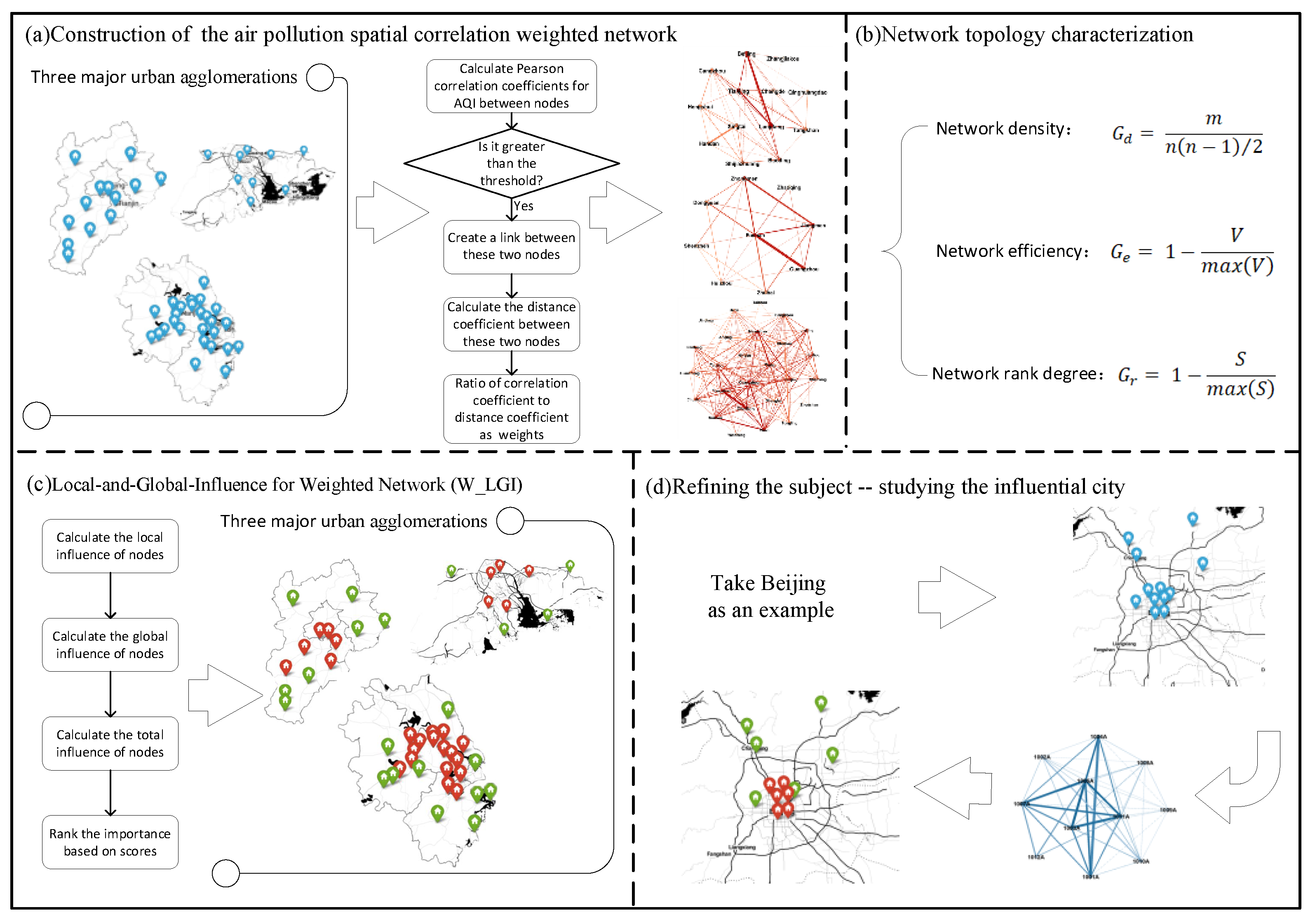
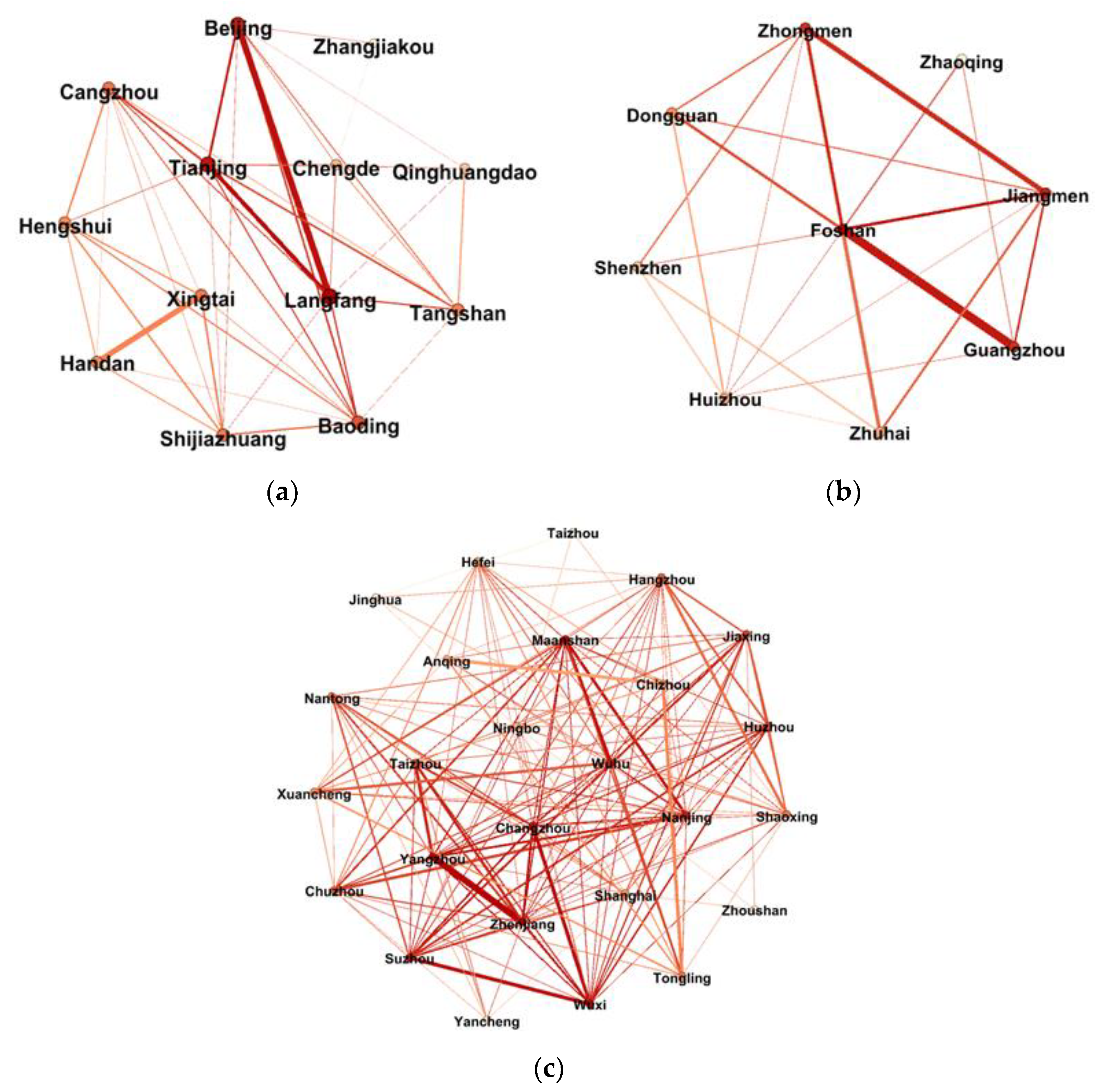
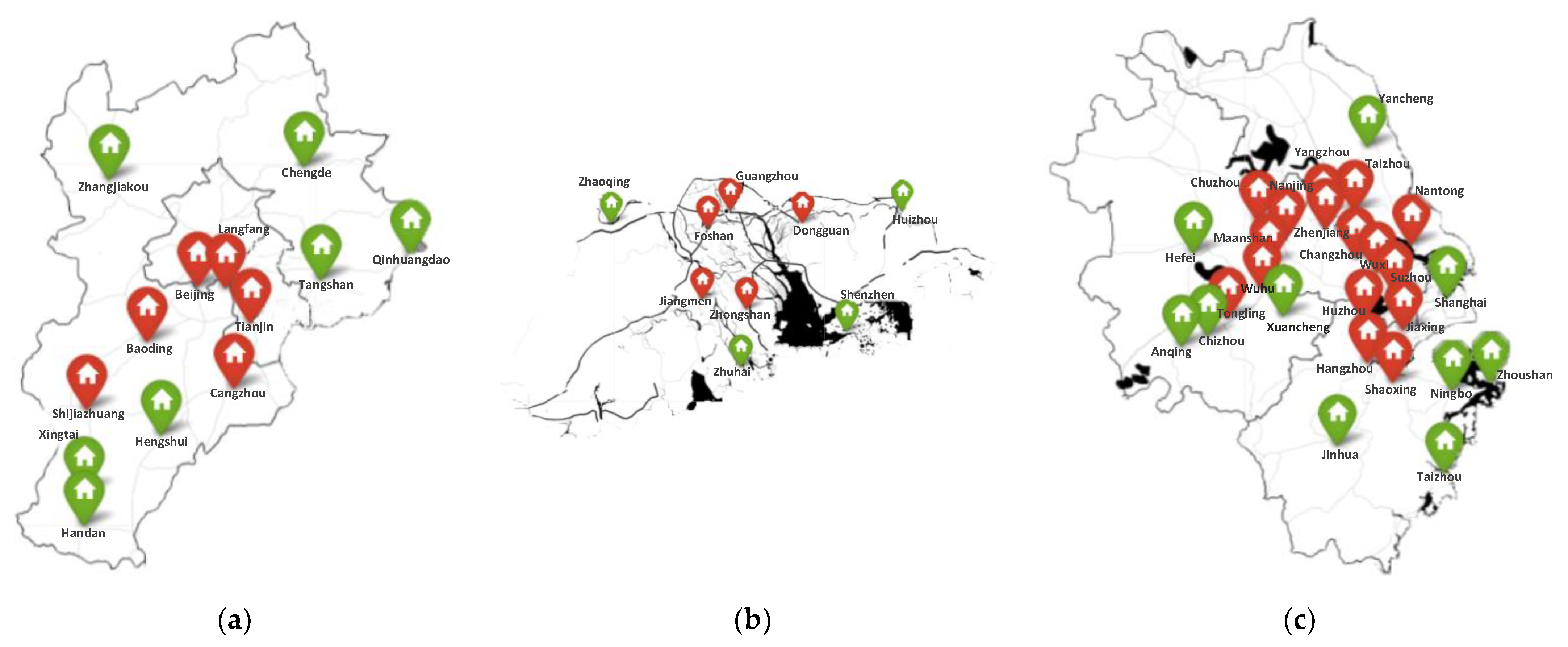
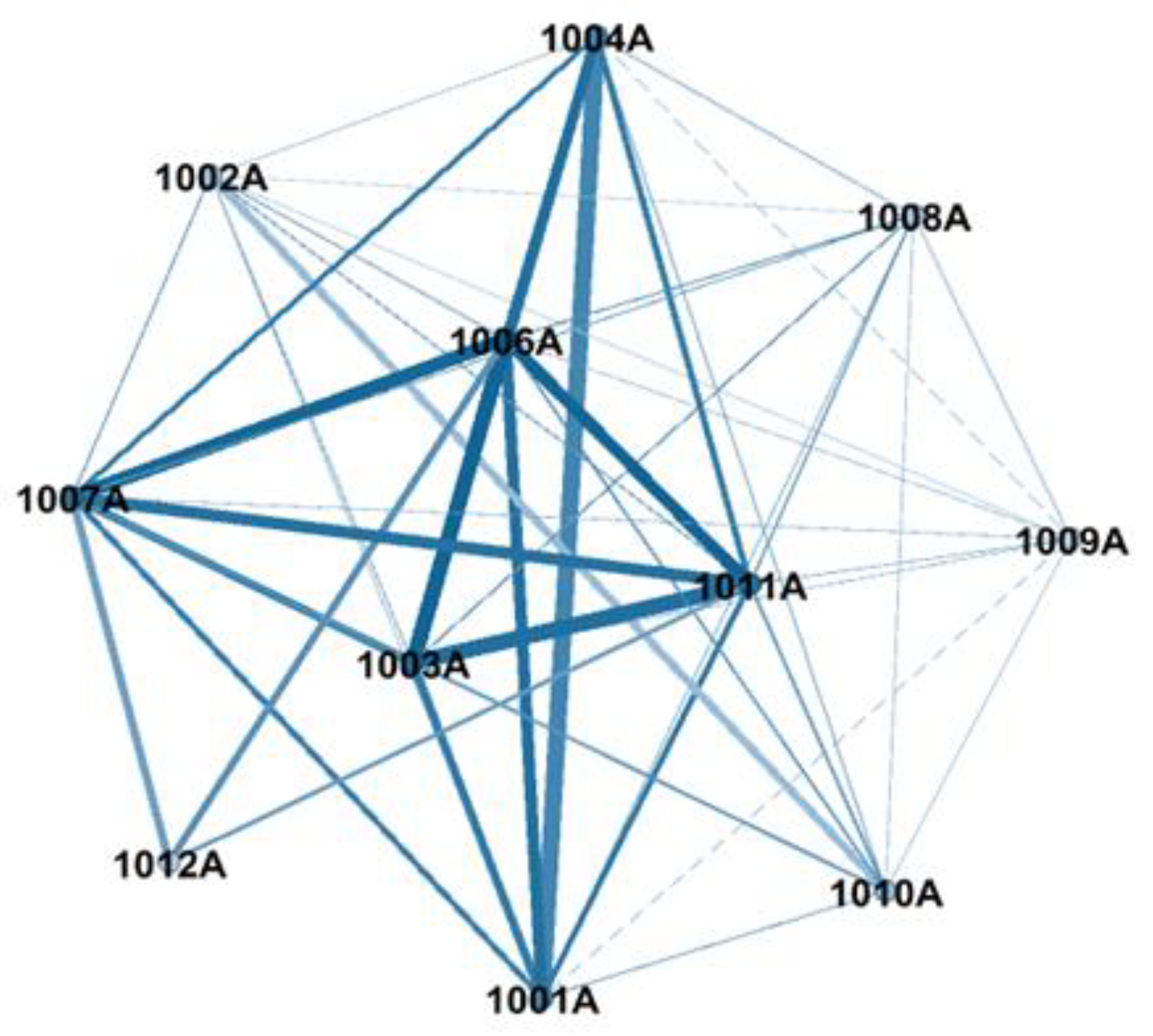
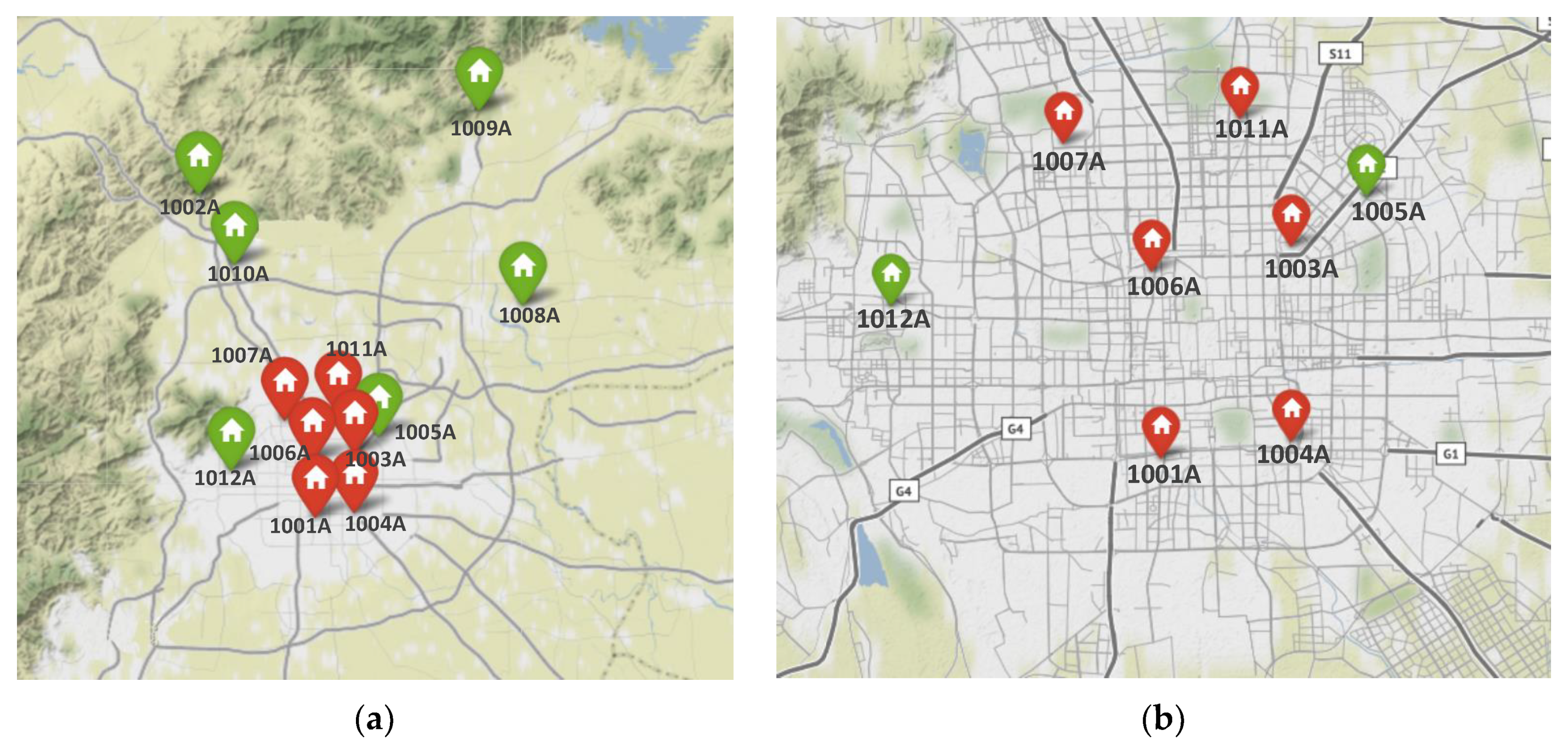
| Number of Nodes (n) | Number of Edges (m) | Network Density (Gd) | Network Efficiency (Ge) | Network Rank Degree (Gr) | |
|---|---|---|---|---|---|
| Beijing-Tianjin-Hebei | 13 | 43 | 0.551 | 0.531 | 0.911 |
| Pearl River Delta | 9 | 23 | 0.639 | 0.476 | 0.992 |
| Yangtze River Delta | 26 | 165 | 0.508 | 0.536 | 0.934 |
| Rank | ||||||
|---|---|---|---|---|---|---|
| (a) | ||||||
| Beijing | 8 | 2.601 | 0.200 | 14.170 | 2.834 | 3 |
| Tianjin | 9 | 2.720 | 0.209 | 14.392 | 3.008 | 2 |
| Shijiazhuang | 8 | 1.778 | 0.137 | 15.065 | 2.064 | 5 |
| Baoding | 9 | 2.133 | 0.164 | 14.488 | 2.376 | 4 |
| Tangshan | 7 | 1.720 | 0.132 | 14.530 | 1.918 | 7 |
| Langfang | 8 | 2.933 | 0.226 | 14.171 | 3.203 | 1 |
| Qinhuangdao | 5 | 0.891 | 0.068 | 14.941 | 1.016 | 12 |
| Zhangjiakou | 2 | 0.299 | 0.023 | 14.043 | 0.323 | 13 |
| Handan | 5 | 1.579 | 0.121 | 14.322 | 1.733 | 8 |
| Hengshui | 6 | 1.597 | 0.123 | 13.886 | 1.708 | 10 |
| Cangzhou | 8 | 1.819 | 0.140 | 14.728 | 2.062 | 6 |
| Chengde | 6 | 1.079 | 0.083 | 14.542 | 1.207 | 11 |
| Xingtai | 5 | 1.786 | 0.137 | 13.781 | 1.888 | 9 |
| (b) | ||||||
| Guangzhou | 5 | 2.036 | 0.226 | 8.743 | 1.978 | 4 |
| Shenzhen | 4 | 0.899 | 0.100 | 9.006 | 0.899 | 8 |
| Zhuhai | 4 | 1.172 | 0.131 | 9.207 | 1.199 | 7 |
| Dongguan | 5 | 1.402 | 0.156 | 8.646 | 1.347 | 5 |
| Foshan | 6 | 2.384 | 0.265 | 8.774 | 2.324 | 1 |
| Zhongshan | 6 | 2.026 | 0.225 | 8.825 | 1.986 | 3 |
| Huizhou | 7 | 1.125 | 0.125 | 10.104 | 1.263 | 6 |
| Jiangmen | 7 | 2.132 | 0.237 | 9.038 | 2.141 | 2 |
| Zhaoqing | 2 | 0.488 | 0.054 | 8.395 | 0.456 | 9 |
| (c) | ||||||
| Shanghai | 13 | 1.767 | 0.068 | 38.689 | 2.629 | 18 |
| Nanjing | 20 | 3.465 | 0.133 | 38.834 | 5.176 | 2 |
| Wuxi | 17 | 3.487 | 0.134 | 37.861 | 5.078 | 3 |
| Changzhou | 17 | 3.297 | 0.127 | 37.952 | 4.813 | 6 |
| Suzhou | 16 | 3.206 | 0.123 | 37.799 | 4.661 | 7 |
| Nantong | 13 | 2.134 | 0.082 | 37.856 | 3.108 | 15 |
| Yancheng | 6 | 0.749 | 0.029 | 37.706 | 1.086 | 23 |
| Yangzhou | 15 | 3.469 | 0.133 | 37.517 | 5.006 | 4 |
| Zhenjiang | 17 | 3.771 | 0.145 | 38.164 | 5.535 | 1 |
| Taizhou | 13 | 2.669 | 0.103 | 36.753 | 3.773 | 11 |
| Hangzhou | 17 | 2.409 | 0.093 | 38.963 | 3.610 | 12 |
| Ningbo | 12 | 1.628 | 0.063 | 38.115 | 2.386 | 21 |
| Jiaxing | 16 | 2.723 | 0.105 | 38.117 | 3.993 | 9 |
| Huzhou | 15 | 2.634 | 0.101 | 37.543 | 3.808 | 10 |
| Shaoxing | 15 | 2.092 | 0.080 | 39.143 | 3.150 | 14 |
| Jinhua | 4 | 0.473 | 0.018 | 36.987 | 0.673 | 25 |
| Zhoushan | 3 | 0.551 | 0.021 | 35.639 | 0.756 | 24 |
| Taizhou | 3 | 0.353 | 0.014 | 36.554 | 0.496 | 26 |
| Hefei | 13 | 1.642 | 0.063 | 38.709 | 2.444 | 20 |
| Wuhu | 17 | 3.093 | 0.119 | 38.365 | 4.564 | 8 |
| Maanshan | 18 | 3.361 | 0.129 | 38.218 | 4.941 | 5 |
| Tongling | 10 | 2.123 | 0.082 | 37.646 | 3.073 | 16 |
| Anqing | 8 | 1.430 | 0.055 | 38.178 | 2.099 | 22 |
| Chuzhou | 14 | 2.306 | 0.089 | 37.740 | 3.348 | 13 |
| Chizhou | 8 | 1.843 | 0.071 | 37.474 | 2.657 | 17 |
| Xuancheng | 10 | 1.817 | 0.070 | 37.169 | 2.597 | 19 |
| Station Number | Station Name | Latitude (°N) | Longitude (°E) | Station Type |
|---|---|---|---|---|
| 1001A | Wanshouxigong | 39.867 | 116.366 | Urban |
| 1002A | Dingling | 40.286 | 116.170 | Suburban |
| 1003A | Dongsi | 39.952 | 116.434 | Urban |
| 1004A | Tiantan | 39.874 | 116.434 | Urban |
| 1005A | Nongzhanguan | 39.972 | 116.473 | Urban |
| 1006A | Guanyuan | 39.942 | 116.361 | Urban |
| 1007A | Haidianquwanliu | 39.993 | 116.315 | Urban |
| 1008A | Shunyixincheng | 40.144 | 116.720 | Suburban |
| 1009A | Huairouzhen | 40.394 | 116.644 | Suburban |
| 1010A | Changpingzhen | 40.195 | 116.230 | Suburban |
| 1011A | Aotizhongxin | 40.003 | 116.407 | Urban |
| 1012A | Gucheng | 39.928 | 116.22 | Urban |
| Station Number | Rank | Station Type | |
|---|---|---|---|
| 1001A | 6 | 4.764 | Urban |
| 1002A | 8 | 2.298 | Suburban |
| 1003A | 2 | 5.582 | Urban |
| 1004A | 5 | 4.795 | Urban |
| 1005A | 12 | 0 | Urban |
| 1006A | 1 | 6.435 | Urban |
| 1007A | 4 | 5.314 | Urban |
| 1008A | 9 | 2.202 | Suburban |
| 1009A | 10 | 1.667 | Suburban |
| 1010A | 7 | 2.658 | Suburban |
| 1011A | 3 | 5.580 | Urban |
| 1012A | 11 | 1.415 | Urban |
Publisher’s Note: MDPI stays neutral with regard to jurisdictional claims in published maps and institutional affiliations. |
© 2022 by the authors. Licensee MDPI, Basel, Switzerland. This article is an open access article distributed under the terms and conditions of the Creative Commons Attribution (CC BY) license (https://creativecommons.org/licenses/by/4.0/).
Share and Cite
Guo, F.; Wang, Z.; Ji, S.; Lu, Q. Influential Nodes Identification in the Air Pollution Spatial Correlation Weighted Networks and Collaborative Governance: Taking China’s Three Urban Agglomerations as Examples. Int. J. Environ. Res. Public Health 2022, 19, 4461. https://doi.org/10.3390/ijerph19084461
Guo F, Wang Z, Ji S, Lu Q. Influential Nodes Identification in the Air Pollution Spatial Correlation Weighted Networks and Collaborative Governance: Taking China’s Three Urban Agglomerations as Examples. International Journal of Environmental Research and Public Health. 2022; 19(8):4461. https://doi.org/10.3390/ijerph19084461
Chicago/Turabian StyleGuo, Feipeng, Zifan Wang, Shaobo Ji, and Qibei Lu. 2022. "Influential Nodes Identification in the Air Pollution Spatial Correlation Weighted Networks and Collaborative Governance: Taking China’s Three Urban Agglomerations as Examples" International Journal of Environmental Research and Public Health 19, no. 8: 4461. https://doi.org/10.3390/ijerph19084461
APA StyleGuo, F., Wang, Z., Ji, S., & Lu, Q. (2022). Influential Nodes Identification in the Air Pollution Spatial Correlation Weighted Networks and Collaborative Governance: Taking China’s Three Urban Agglomerations as Examples. International Journal of Environmental Research and Public Health, 19(8), 4461. https://doi.org/10.3390/ijerph19084461






